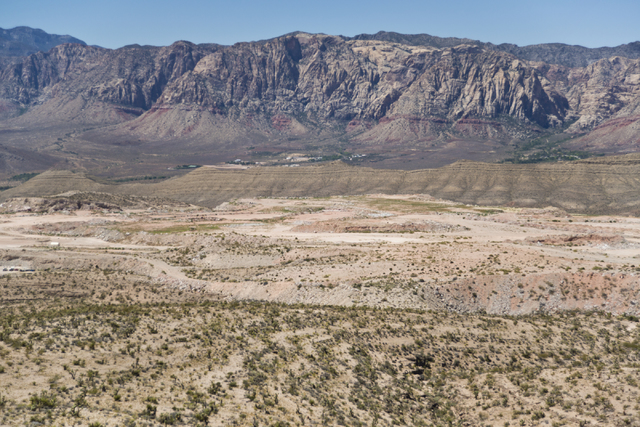Why all the controversy about Blue Diamond Hill? Here’s the rundown

A contentious plan to develop about 5,000 homes on Blue Diamond Hill is moving forward after last week’s Clark County Commission meeting.
Developer Jim Rhodes’ desire to build a master-planned community near Red Rock Canyon has drawn the ire of outdoor enthusiasts for more than a decade.
If you’re a little lost, don’t worry. Here are answers to some common questions about the proposal:
What is Blue Diamond Hill?
Blue Diamond Hill is a historic gypsum mine, one of the world’s largest. It is 15 miles west of the Strip, east of the town of Blue Diamond and southeast of Red Rock Canyon’s scenic loop.
The property’s owner, Gypsum Resources, wants to build a master-planned community containing 5,000 homes on some 2,000 hilltop acres as the area’s post-mining future.
Where is Blue Diamond Hill in relation to Red Rock Canyon?
Much of the property abuts the conservation area, but the top of Blue Diamond Hill is about 3½ miles from the park’s visitor center. The area’s most popular trails are behind that.
Why is the development so contentious?
Many people living in and outside the Las Vegas Valley believe that building on Blue Diamond Hill will adversely affect the nearby Red Rock Canyon National Conservation Area. Hundreds of people attended the County Commission meeting to protest development.
They argued that development will damage the local ecosystem by increasing pollution, mar the skyline and overburden state Routes 159 and 160 with traffic from thousands of vehicles.
Others posited that lights from the development will make it harder to see stars. The deputy chief of the Blue Diamond Volunteer Fire Department said he was worried about increased demand on his crews. A geologist warned commissioners that building on or near an old mine site could put homes in danger of sinkholes.
Who uses Red Rock?
The area has more than 2 million visitors annually. It’s a popular destination for hiking, rock climbing, cycling, horseback riding and sightseeing.
Who is Jim Rhodes?
Rhodes is a developer and the trust manager for Gypsum Resources and, in previous years, has been the face of the proposed development. In the early 2000s, he was featured in TV advertisements about the proposal.
Rhodes has more recently taken himself out of the project’s spotlight.
What has the government done about the plan?
The government has tried — at the local, state and federal levels — to stop the plan.
In 2003, the Clark County Commission and the Nevada Legislature passed laws to freeze zoning changes on the land Gypsum Resources wants to develop. The land’s zoning would have prevented more than about 1,200 homes from being built. Gypsum Resources wants to build up to about 5,000.
The company sued both governments. The Nevada Supreme Court overturned the state law, and the county settled, making higher-density zoning possible.
And the federal government?
The U.S. Bureau of Land Management and Gypsum Resources tried to work out a land swap for the Blue Diamond Hill property, but those negotiations ended in 2014 because BLM didn’t want lands affected by mining.
What would a 5,000-home development include?
According to a specific plan draft Gypsum Resources submitted to the county in late 2011, the community could have as many as 14,300 residents. About 2,000 would be schoolchildren.
A six-lane access road would need to be built to connect to state Route 160, which also would probably need to be modified to accommodate increased traffic. The 2011 specific plan estimated the community, on average, would need 7.1 million gallons of water a day.
Why did the County Commission discuss the development?
Commissioners were asked to approve a concept plan, the first step in the county’s major projects process, that Gypsum Resources submitted last year.
Instead, commissioners decided that a similar, already-approved plan submitted in 2011 had never expired.
Why didn’t the 2011 concept plan expire?
Because Gypsum Resources submitted a draft of its specific plan within a year of August 2011, when the previous concept plan was submitted. At the time, the county code didn’t place a time limit on the approval of the specific plan, county attorney Robert Warhola has said.
Why did the developer submit a new plan in 2016?
That remains a bit foggy, but it appears some county staff believed the 2011 plan had expired during the failed land exchange talks with BLM and requested Gypsum Resources submit a new concept plan.
So Gypsum Resources can now build homes on Blue Diamond Hill?
Not yet. There are more steps to the major projects process that must be completed before construction can start. The county will consider allowing developments of up to 5,000 homes.
Commissioners could lower that cap, and they will have to approve changing the land’s zoning before that many homes could be built.
What happens next?
Gypsum Resources needs the Bureau of Land Management’s permission to build a road connecting to state Route 160.
A study on the impact to the road will be conducted. Then the company will submit a more detailed plan including zoning change requests.
Gypsum Resources must also complete an additional report that will assess its expected impact on traffic, emergency services, water supply and habitat conservation.
All of that will need to be approved by county staff and commissioners before construction can start.